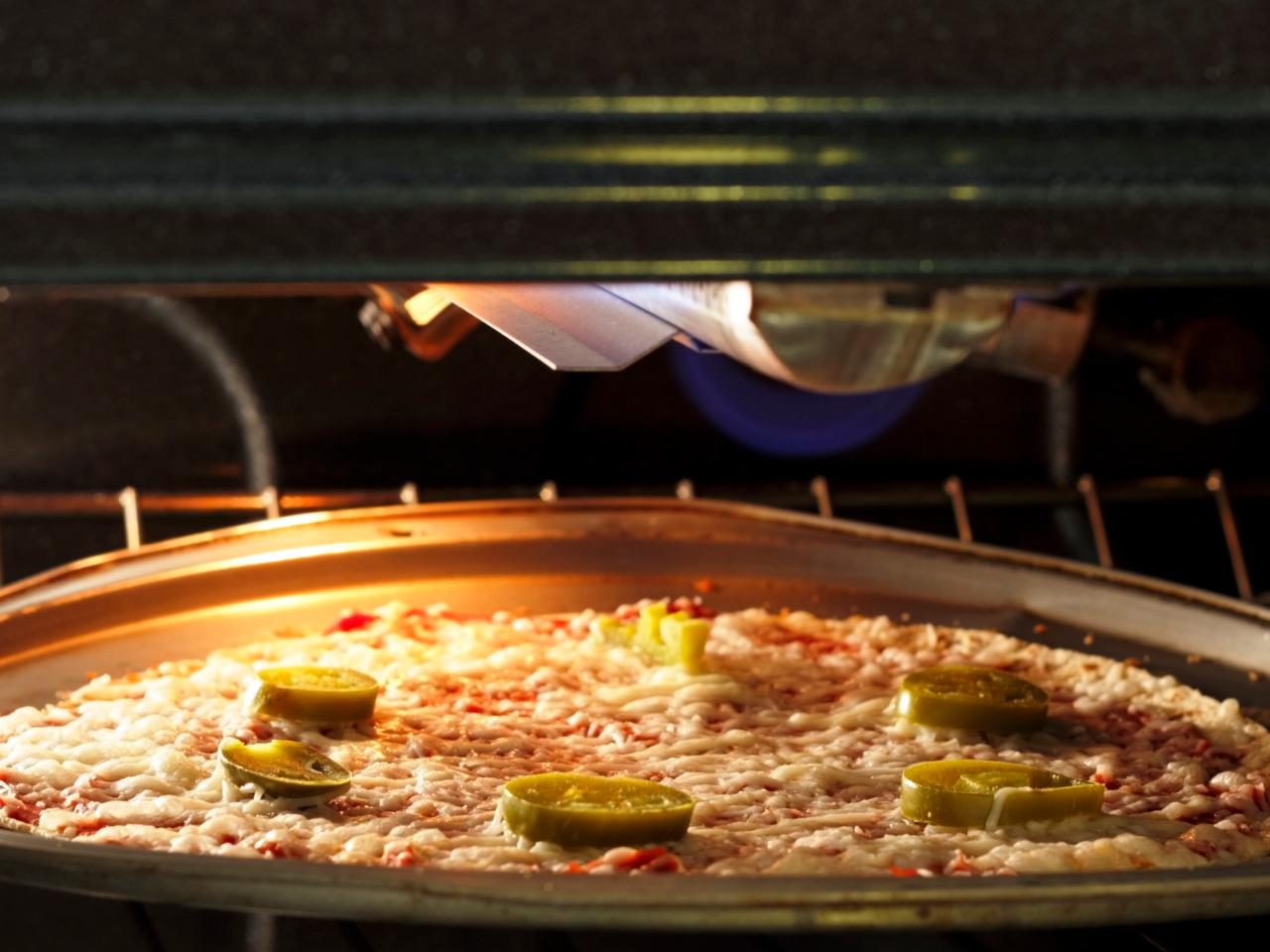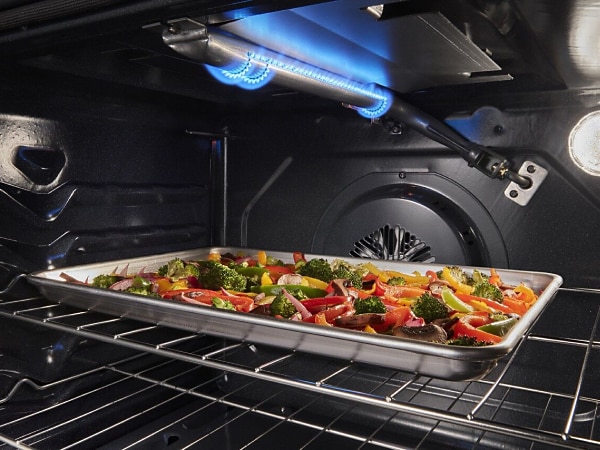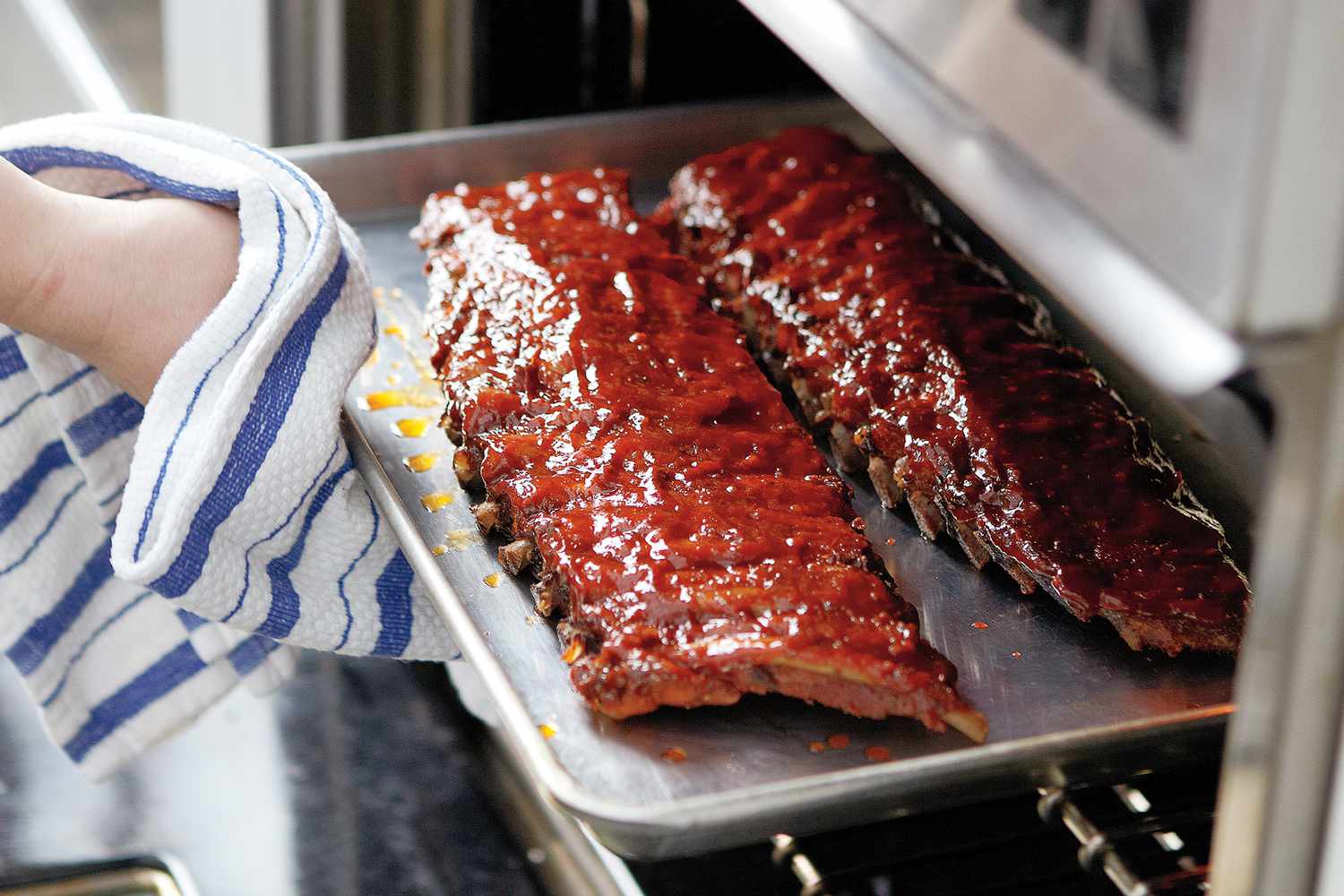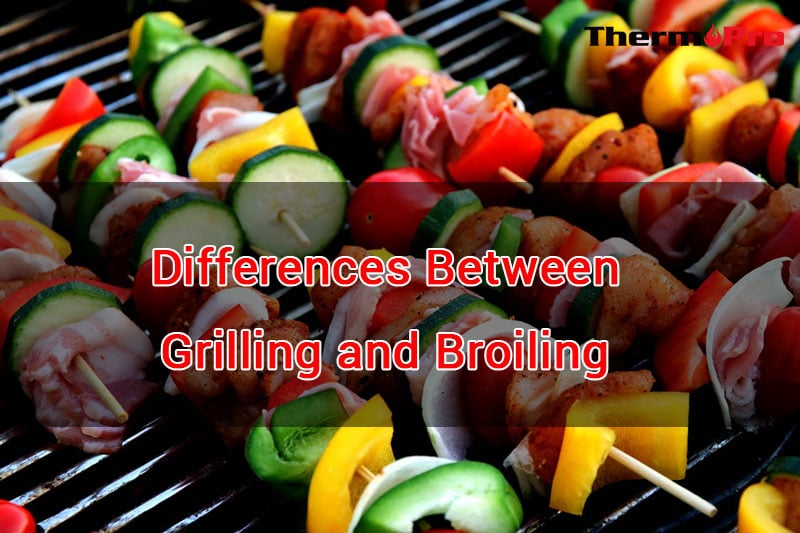Introduction

The introduction provides an overview of the cooking techniques of broiling and grilling. While the terms are often used interchangeably, there are important differences between the two methods. Broiling involves cooking food directly under intense heat, typically from an overhead heat source, while grilling utilizes heat from below, with the food placed on a grate. This article aims to explore the definitions, benefits, and drawbacks of broiling and grilling, as well as the factors to consider and the potential impact on food nutrients. By understanding these techniques, readers can make informed choices when it comes to cooking different types of food.
Overview Of Broiling And Grilling Cooking Techniques
Broiling and grilling are two popular cooking techniques that involve the use of intense heat to cook food. Broiling involves cooking the food directly under high heat, usually from an overhead heat source, such as a broiler in the oven. On the other hand, grilling utilizes heat from below, with the food placed on a grate above the heat source, such as a charcoal or gas grill. Both techniques result in deliciously charred and flavorful food, but they have their unique differences in terms of heat source and cooking method.
Differences Between Broiling And Grilling
Broiling and grilling are two cooking techniques that may seem similar, but they have distinct differences. The main difference lies in the heat source and the position of the food in relation to the heat. With broiling, the heat source is from above, and the food is cooked directly under the intense heat. On the other hand, grilling involves heat from below, with the food placed on a grate above the heat source. This difference in heat positioning creates variations in cooking methods, flavors, and textures of the food. Lastly , Broiling tends to be a faster cooking method compared to grilling, as the heat from above quickly cooks the food, while grilling usually takes longer due to indirect heat.
Broiling Technique

Broiling is a cooking technique that involves using high heat from an overhead heat source, typically found in an oven. The food is placed on a rack or a broiler pan directly under the heat source. The intense heat quickly cooks the food, creating a sear and caramelization on the surface. This technique is ideal for cooking thinner cuts of meat, fish, and vegetables, as it allows for quick and even cooking. Broiling is a convenient option for those who do not have access to an outdoor grill and want a similar charred and smoky flavor in their dishes.
Definition And Explanation Of Broiling
Broiling is a cooking technique that involves using high heat from an overhead heat source, typically found in an oven. The food is placed on a rack or a broiler pan directly under the heat source. The intense heat quickly cooks the food, creating a sear and caramelization on the surface. This technique is ideal for cooking thinner cuts of meat, fish, and vegetables, as it allows for quick and even cooking. Broiling is a convenient option for those who do not have access to an outdoor grill and want a similar charred and smoky flavor in their dishes.
Advantages And Disadvantages Of Broiling
Broiling offers several advantages as a cooking technique. First, it allows for quick and efficient cooking, making it ideal for busy individuals. Additionally, broiling creates a delicious sear and caramelization on the surface of the food, resulting in a flavorful and visually appealing dish. Furthermore, broiling is a convenient option for those who do not have access to an outdoor grill. However, there are also some disadvantages to broiling. The high heat of broiling can cause food to cook unevenly if not properly monitored. Additionally, broiling can produce smoke and splatter, requiring extra care and clean-up.
Grilling Technique

Grilling is a popular cooking technique that involves cooking food directly on a grill over an open flame or heated grill grates. The food is exposed to high heat, resulting in delicious char marks and a distinct smoky flavor. Grilling is often associated with outdoor cooking and is a favorite method for preparing burgers, hot dogs, vegetables, and even pizzas. It offers the advantage of fast cooking times and the ability to infuse food with a unique grilled flavor. However, grilling can be challenging to control temperature-wise and may require more hands-on attention to prevent burning or undercooking.
Definition And Explanation Of Grilling
Grilling is a cooking technique that involves cooking food directly on a grill over an open flame or heated grill grates. The food is exposed to high heat, which creates a unique and delicious charred flavor. Grilling can be done using various heat sources, including charcoal, gas, or electricity. It is often done outdoors, making it a popular choice for backyard barbecues and picnics. Grilling is not only limited to meats, but it can also be used to cook vegetables, seafood, and even fruits. It offers a fast cooking time and imparts a smoky and grilled taste to the food. Grilling is a versatile cooking method that allows for a wide range of flavors and textures to be achieved.
Advantages And Disadvantages Of Grilling
Grilling has several advantages that make it a popular cooking technique. First, it imparts a unique and delicious smoky flavor to the food, enhancing its taste. Second, grilling allows excess fat to drip away from the food, making it a healthier cooking option. Additionally, grilling is a versatile method that can be used to cook various types of food, including meats, vegetables, seafood, and fruits.
However, grilling also has some disadvantages. One challenge is maintaining consistent heat, as the temperature can fluctuate depending on the grill and external factors like weather conditions. Grilling can also lead to the formation of potentially harmful compounds, such as polycyclic aromatic hydrocarbons (PAHs) and heterocyclic amines (HCAs), when meat proteins char or burn. To minimize this risk, it’s important to use proper grilling techniques and avoid excessive charring.
Factors To Consider

When deciding between broiling and grilling, there are a few factors to consider.
For broiling, temperature control is crucial as the heat comes from above, so it’s important to adjust the cooking time accordingly. Additionally, different foods may require different distances from the broiler element to achieve the desired level of browning and doneness.
On the other hand, grilling requires attention to temperature control as well. It is important to preheat the grill properly, as well as monitor and adjust the heat during cooking to prevent burning or undercooking.
Considering these factors will ensure that you choose the right cooking method for your specific dish and achieve the best results.
Temperature Control And Cooking Time For Broiling
Temperature control is crucial when broiling because the heat comes from above. It is important to adjust the cooking time accordingly to ensure the food is cooked to perfection. The distance between the broiler element and the food also affects the cooking time and the level of browning. To achieve the desired level of doneness, the food may need to be placed closer or further away from the broiler element. It is recommended to preheat the broiler and monitor the cooking process closely to prevent burning or undercooking.
Temperature Control And Cooking Time For Grilling
Temperature control is important when grilling to ensure that food is cooked to the desired level of doneness. The cooking time for grilling varies depending on the type and thickness of the food being cooked. Here are some general guidelines for temperature control and cooking time when grilling:
- Preheat the grill to the desired temperature before adding the food.
- For high heat grilling (around 450-550°F/230-290°C), food such as steaks, burgers, and vegetables should be cooked for 4-6 minutes per side for medium-rare.
- For medium heat grilling (around 350-450°F/180-230°C), food such as chicken breasts and fish fillets should be cooked for 6-8 minutes per side.
- For low heat grilling (around 250-350°F/120-180°C), food such as larger cuts of meat or whole chickens may require longer cooking times, ranging from 20-40 minutes per side.
It is important to monitor the food closely and adjust the cooking time as needed to avoid overcooking or undercooking. Using a meat thermometer can also help ensure that the food reaches the recommended internal temperature for safety.
Nutritional Differences

When comparing broiling and grilling, there are some nutritional differences to consider. Broiling tends to retain more of the natural juices and flavors of the food. However, it can also cause some nutrient loss, as the juices that contain vitamins and minerals may drip away. Grilling, on the other hand, can help to lock in vitamins, minerals, and moisture, making the food juicy and tender. However, grilling may lead to a reduction in certain nutrients, such as vitamin B, due to the dripping of nutrient-rich juices from the meat. It is important to consider these factors when choosing a cooking method to ensure a balance of taste and nutrition.
Effects Of Broiling On Food Nutrients
Broiling is a cooking technique that uses high heat from above to cook food. While broiling can help retain the natural juices and flavors of food, it also comes with some drawbacks in terms of nutrient loss. The intense heat and direct exposure can cause vitamins and minerals to be lost as the juices drip away. This means that some nutrient-rich components may not be fully retained in the food during the broiling process. It is important to consider this when deciding on the cooking method to ensure a balanced intake of essential nutrients.
Effects Of Grilling On Food Nutrients
Grilling is a cooking technique that can affect the nutrient content of food. The high heat used in grilling can cause some nutrient loss, particularly vitamins and minerals that are heat-sensitive. Additionally, when meat is grilled, fat drips off and can result in a reduction of certain nutrients. However, grilling can also have some nutritional benefits. Grilling can help retain the natural juices and flavors of food, making it a healthier cooking method compared to frying or sautéing in oil. It is important to balance the benefits and drawbacks of grilling to ensure a varied and nutrient-rich diet.
Conclusion

In conclusion, broiling and grilling are two distinct cooking techniques that offer their own advantages and drawbacks. Broiling is a method that uses direct heat from an overhead source, making it ideal for cooking thinner cuts of meat and achieving a quick and even sear. On the other hand, grilling involves cooking food over an open flame or heated grates, providing a smoky flavor and the opportunity for outdoor cooking. Ultimately, the choice between broiling and grilling depends on personal preference, the type of food being cooked, and the available equipment. Both methods can produce delicious results when utilized correctly.
Comparison Of Broiling And Grilling Techniques
When comparing broiling and grilling techniques, it’s important to consider the heat source and the cooking process. Broiling uses direct heat from above, while grilling uses heat from below. This difference results in distinct flavors and textures. Grilling over wood or charcoal produces a smoky flavor, while broiling provides a quick and even sear. Grilling allows for outdoor cooking and the opportunity to use natural gas or a pan to create a grill effect. However, broiling is convenient for indoor cooking when grilling outdoors is not possible. Both techniques have their advantages and can produce delicious results.
Choosing The Right Cooking Method For Different Types Of Food
When it comes to choosing the right cooking method for different types of food, there are a few factors to consider. For tender cuts of meat like steaks and chicken breasts, grilling is a popular choice as it adds a smoky flavor and creates a charred crust. Broiling, on the other hand, is ideal for thin cuts of meat, fish, and vegetables as it provides a quick and even sear. Additionally, grilling is perfect for larger cuts of meats like ribs or whole poultry, while broiling is better suited for smaller portions. It’s important to consider the texture and thickness of the food when deciding whether to grill or broil. Ultimately, experimenting with both techniques will help you determine which one works best for different types of food.
FAQ: Broiling vs. Grilling
1. What is the difference between broiling and grilling?
Broiling and grilling are both popular cooking methods that involve applying high heat to food. The main difference lies in the direction of heat and the cooking source. Broiling uses radiant heat from above, while grilling uses direct heat from below.
2. How does broiling work?
Broiling is done by exposing food to direct heat from an overhead source, typically in an oven. The heat source is situated on the ceiling of the oven, and it emits intense heat that quickly cooks the food. This method is great for achieving a caramelized top layer and crispy texture.
3. How does grilling work?
Grilling involves cooking food directly over an open flame or a hot surface, such as a grill or barbecue. The heat is generated below the food, producing distinctive grill marks and a smoky flavor. Grilling is often associated with outdoor cooking but can be done indoors using a stovetop grill or electric grill.
4. Which method is healthier?
Both broiling and grilling can be healthy cooking methods, as they allow excess fats to drip away from the food during cooking. However, it’s important to consider the choice of ingredients and the cooking time to maintain the nutritional value of the food. Grilling can be a healthier option as it requires less oil or fat to cook the food compared to broiling.
5. Which method is better for meats?
Both methods work well for cooking meats, but they offer slightly different results. Broiling is ideal for thin cuts of meat, such as poultry breasts or fish fillets, as it quickly cooks them and creates a delicious crust. Grilling is better suited for thicker cuts of meat, such as steaks or burgers, as it allows for more even cooking and imparts a smoky flavor.
6. Can I broil or grill vegetables?
Absolutely! Both broiling and grilling are excellent methods for cooking vegetables. Whether you want to roast vegetables under the broiler or place them directly on the grill grates, they will develop a wonderful char and smoky taste. Just remember to adjust the cooking time and keep an eye on them to prevent overcooking or burning.
7. Can you broil or grill fish?
Yes, both broiling and grilling are fantastic for cooking fish. Broiling is particularly suitable for delicate fish like salmon or tilapia, as it gently cooks them while keeping the flesh moist. Grilling fish on a well-greased grill grate or wrapped in foil enhances the natural flavors and creates a satisfying smoky taste.
8. How do I ensure food cooks evenly when broiling or grilling?
To ensure even cooking, it’s important to preheat the broiler or grill before placing the food inside. Also, try to arrange the food in a single layer, leaving space between the pieces, allowing the heat to circulate. For thicker cuts of meat, consider using a meat thermometer to check for doneness.
9. Are there any safety precautions to keep in mind?
When broiling or grilling, always exercise caution as the high heat involved can cause flare-ups or burns. Keep a close watch on the food to prevent charring or flare-ups, and use proper heat-resistant gloves or utensils when handling hot surfaces. Ensure that your cooking area is well-ventilated, especially when grilling indoors.
In conclusion, both broiling and grilling are versatile cooking methods that can bring out unique flavors in your food. Whether you prefer the intense heat from the broiler or the smoky goodness of a grill, these techniques offer endless possibilities for creating delicious and satisfying meals.

From At-Home Dinner Parties to Family Reunions to Office Parties, we can cater your next Event!